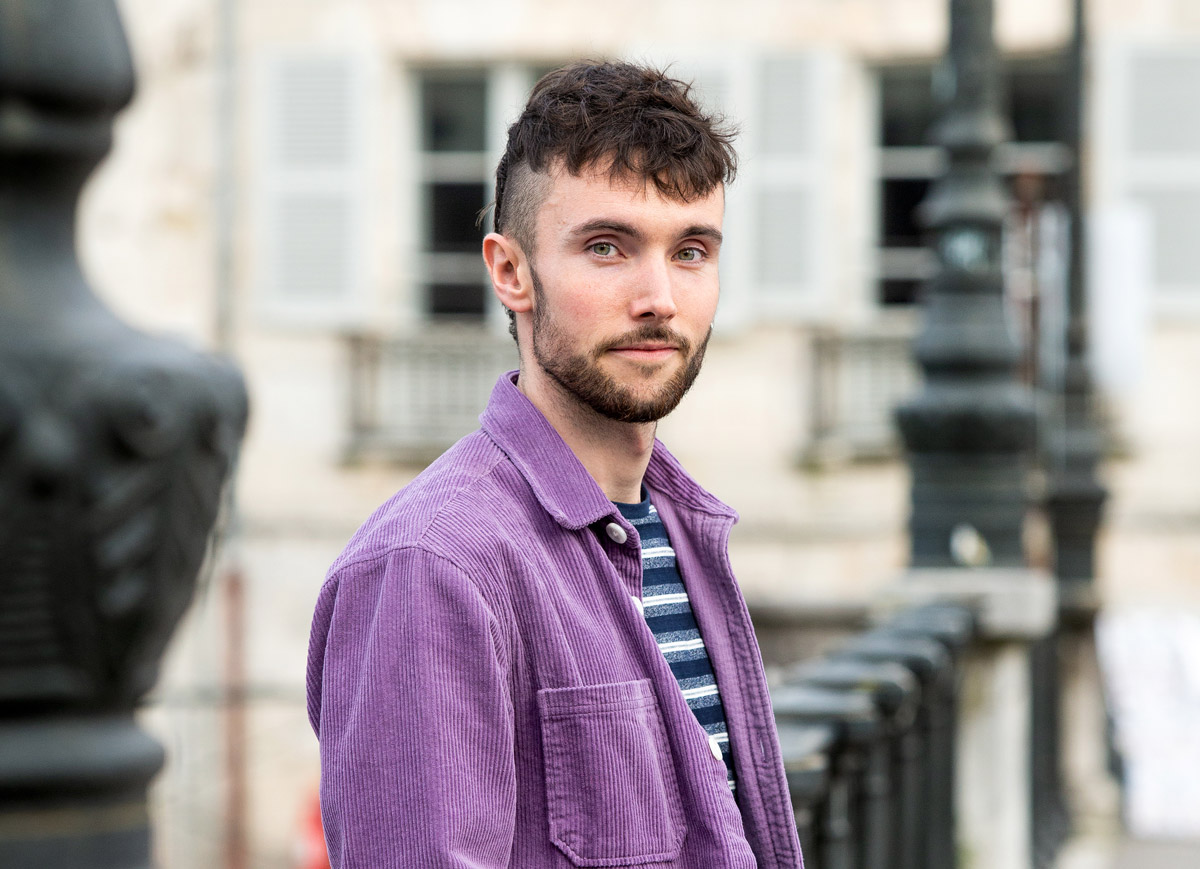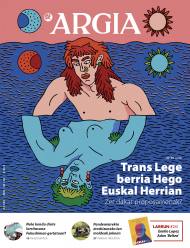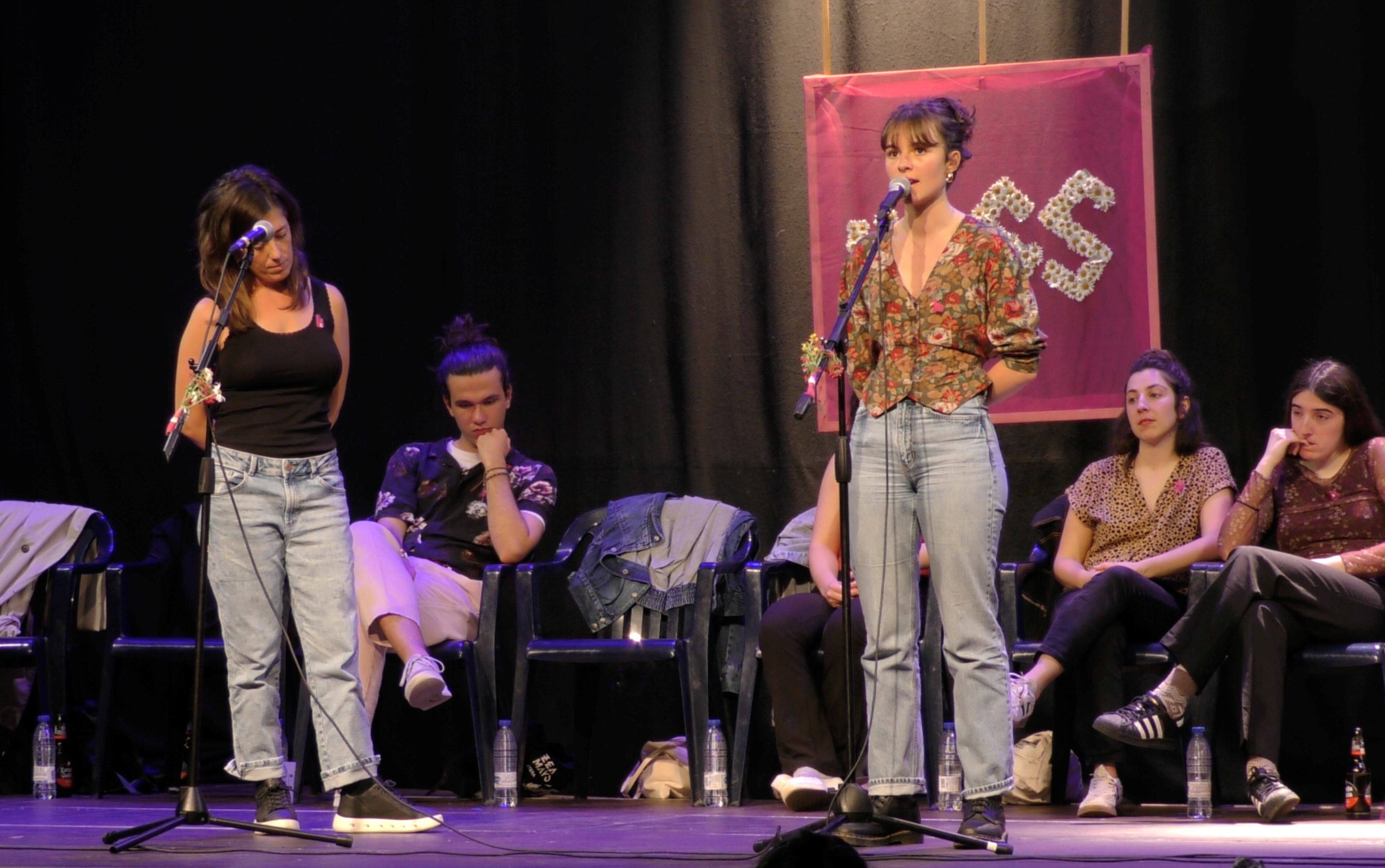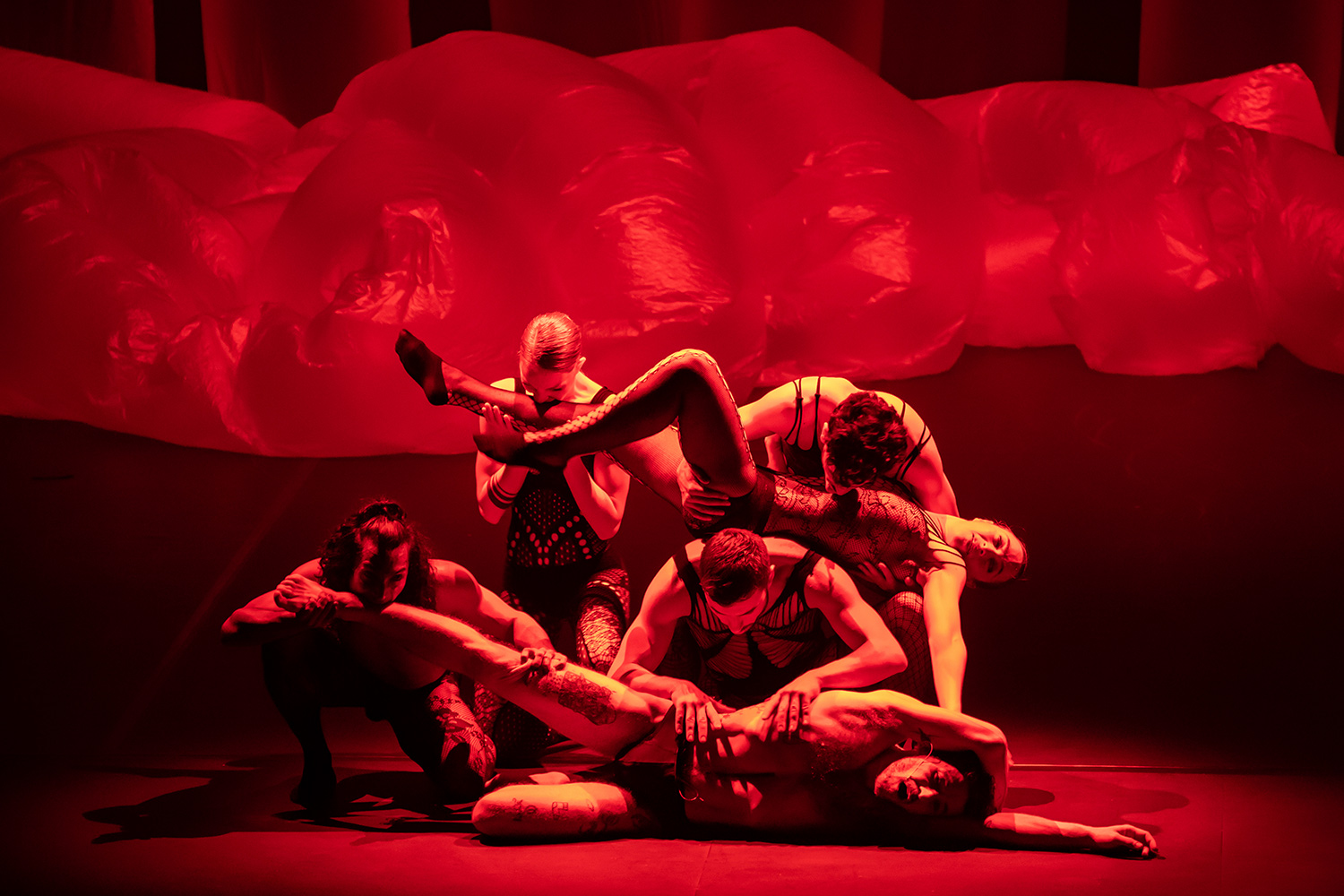"Changing the head changes the body and vice versa"
- As he understood otherwise what he learned from hearing in the conservatory, he now observes what he learned in Basque dances from contemporary dance. No hierarchies between them. Without leaning towards the dichotomy between creation and tradition. Indar dances theirs between the truths of each other.

Hainbat dantza taldetan ibili ondoren, Bilaka kolektiboko dantzari profesionala eta zuzendaritzako kidea da. 6 urterekin hasi zen, ofizialki, baina egiazki bizi osoa darama dantzan. Baionako kontserbatorioan musika ikasi du, fakultatean Euskal Ikastetak, baina gorputzak dantzaren bidea aukeratu dio.
When and how did she start dancing?
As an official date, I refer to the age of 6, which is when I started in the Arrola de Baigorri dance group. But before I also danced. Izan in Baigorri or in Pamplona. I have always been between these two peoples, one father and another mother. And in the two, I grew up in a party atmosphere, between music and singing, dancing to dance. At home there is a video with my mother who at the age of 3 I am dancing the Larrain dantza in the plaza del Castillo. That's how it was, looking at me: people on one side, then on the other, now translated and now you jump. Jump, jump, jump! It bothered me, but I was happy. Music has always been a part of my day to day. We have walked with a toy atabal in the parades of the Giants of Pamplona, along with the mother, and on the part of my father, in the family meals we all sang two and three mouths…
What memories are there in Arrola?
I remember above all the social. All my friends were in the group and we were going from the ikastola to dance. I remember the pleasure of playing a role in the village. Kabalkada, Navarra Day… Your year marks being in a group of dances. I have a group of friends the ukatea, that if in the village celebrations it was a dance it would not go to the other side of the village. No, no, we were there, in the dance, of everyone and of everyone, sweating… I remember that social pleasure. Actions, trips, etc... the experience that makes you part of a team.
In Baigorri we have had the appearance of Christ, because our previous generations have been able to convey that way of living dance. This dynamic, this presence in the people, the passion for exchanges… Their motivation was based, among other things, on socio-political ideas that can sometimes be difficult to retain…
When and how did dance take another place in your life?
It's curious. I also loved music, a lot – I learned the pandereta and trikitixa as a child, for about seven years – and I studied at the Cassin de Baiona High School, near the conservatory. After doing the low scientist, I didn't know what to do, and I signed up for Basque Studies in the Faculty of Baiona -- for interest in the Basque Country, of course, but because I wanted to continue in the music in the conservatory sustut. That was my priority at the time.
And in the end, as I got into college, dance took up more space in my day to day. The group “The Future Concepts” emerged, which was the beginning of what would later become a collective Bilaka. From there came some mail messages and from here… In that group young people gathered from the interior and from the coast. They were dynamic people. Wanting to work, with the objective of orienting the Basque dance towards creation. They created their first performances and were teaching courses. I landed in a kind of learning from Zuberoa's dances, and since then I've been there.
I also participated in other projects in those three years of college. I've been a boy, I've been opened many doors. There are no kids! With Pascal Lazkano, in the Senpereño group Zarena Zarelako, on the one hand, and with Jon Iruretagoiena in the company Maritzul, he opened “Well, a new child!” and the doors opened to me. I continued at Arrola, I also worked as a teacher... but next door I started to make another way. As an alternative to the spectacular ones that were underway at the beginning, then part of the new spectacular… Call, replace, estate. In those years, that's how I went. I received incredible training, doing a deep job in Basque dance. Sharpening the technique.

And all of a sudden she became a professional dancer of the company EliralE…
In that dance boom, in a Aiko Group jota course, I crossed over to Pantxika Telleria, founder of the EliralE Company. Then, in the last year of college, I heard an open call to integrate two young people into the training. I was at the end of the license and I didn't have any other projects. I am told, then, as now, that I managed with what I ate, if I had it right. “Has this come? Well, come on!” I did a hearing and they took me. That summer, I was already working with EliralE at the Avignon festival. & '97; My first failed sanfermines. I think that's where I became a professional dancer. Accepting the path of EliralE, he opted for it. We were guaranteed the status of intermittence. I ended my license and I was guaranteed economic stability, what and what I wanted to do!
The difference between Basque dance and contemporary dance… How was the transition?
I had to do it slowly. By imitation, by essay, by patience… Opening the mental limits and touching ahead. I don't think there are any other secrets.
I went into the company with another girl. That girl had traveled Bordal, at the Ballet Junior de Aquitaine, from a classical contemporary experience. There I flipped. Wow! That is the body that has been working for several years to do so. Therefore, you are attacking that difference. Physics. There are muscular pathways that we do not use violently in Basque dances. To dance to an individual, it is not necessary to know the whole anatomy of the body. Therefore, to compensate it, it is up to you to work a muscle that has not been used in the section. I lost the pounds. The body understood that we went to something else. And it's frustrating, because it says that instead of building you have to desire. So go and undo everything and start at the bottom…
I remember, in Xihi's performance, that at first it was a tree. Tree? Until then I was not a tree! And Pantxika, with her body reading, tells you about your neck rings, the curve of your spine, the vertebrae... And he says to you, “It’s a snake, take advantage!” and you heal a stick on your back…
And besides the limits of the body, are there any other limitations?
Moving to the contemporary implies translating and inverting all the mechanisms of your head. Mechanically, when a leg has to go from the top, you may think that “grab from the top and throw”, or you can rise below as if you’re out of arms. Changing schemes can change everything often.
They also change intentions, impulses, accents. In Basque dances, it's not a general truth, but the time of pigeon music, the pulse, attaches to the earth. Pulse, earth, pulse, earth. Therefore, movement arises from the rhythm of the legs. So you have to discover other accents that don't stick on the ground. For example, you can dial it in the air. In the elbows, elbows, breath. And as a Basque dancer, you have not naturally grasped that way of dancing.
The Basque dancers have a tendency to think about shapes. When you want to learn a dance, you imitate the way. You don't think, "What are you thinking about giving that dance?" And in the contemporary, it's necessary.
It implies the awareness of oneself, that is, of the body. Anitz goes through her head. How you experience the movement in your head. How do you think about dance? The head change changes the body. And vice versa. And my question is, now, working all of that, blocking all of that and turning it all over, what about the Basque dancer you are?
What stick from Basque dance to Basque contemporary dance?
The same thing. We are Basque dancers, born of a popular broadcast. This can be lived as a complex. Everything we've received as an obstacle to contemporary dance. But on that path are we forced to undo everything to make it more conventional or more academic? Doesn't it add value to what we know, what we do, what we are?
That is where I see the current challenge. In fact, we're not building on anything. Nobody is a white sheet, a universal axis. Neither of them. No rules. So that paleness of our back is also something. This leads to a physical complexion. A way to dance, not everything thought for the scene, but with its own sense.
So what do we hold back from ourselves? How to define contemporary Basque dance? What's left for you when you go up on a stage knowing that you're a body trained in the dances created for the place in the smell? What do we do with that matter that we're denaturalizing by changing the context?
With search, we're referring to that. How will a dancer who works in the Bilaka collective differ from a dancer who has worked in a Berlin dance company? What is contemporary Basque dance? We're trying to build a way consciously. Because, whether you're aware or not, some decisions are made.
"Will we be forced on that road to undo everything to turn it into something more conventional or more academic? Does not add value to what we know, what we do, what we are?”
And with the Basque dances what?
Different organisations carry out different tasks. Everything is needed. On the one hand, investigating, collecting, analyzing and knowing what we have in our hands. And on the other hand, to invent ways to give play and experience to that component. The compilation work is of vital importance, in which I admire the work of the Argia dance group, for example, as a result of Urbeltz’s research. But the goal should not be to set the dances and turn them into pieces of the museum. Sometimes the fact that things get too rough, drowns them.
We all change. Times change. So is society. And it can be frustrating to see how the dance changes forever. But some ceremonies of the time have not withheld it. Some dances have lost their social function. That's what we have to be inventors in.
So far the scene has been worked on as an alternative. He was lost in the plaza to win on the board. But at the same time, we must continue to develop this invention outside the scene for the people and the plaza. Without contemporary dance, it doesn't seem to be innovative, but it's possible. I love the work of the Aiko group. Understand fandango as an intense game of paired improvisation. I am glad to know that people are working on it, and that, therefore, there will be a long time in the fandango! If we consider Basque dance obsolete, it's because we haven't discovered it completely. However, you have to know the matter in order to be able to play with the matter.
In this, I do not believe that all dance groups have the objective of superficially dominating all the dances of Euskal Herria. What we have is what the dance group has done, for example, I am interested in. Part of his work has shifted to focusing on local dances: “What are we? What do we want? What does our people need?” With the resources and support that surrounded them, they have created dances that were tastefully built, new traditional dances. The traditional is not only what has been danced for a long time, but it is able to endure in time, linked to ritual and social function. The pandemic has highlighted the need for this role. A groove or almost a trance that can bring you a mutxiko dancing at home, in a plaza, with so many people...
Despite the smaller number of children in dances and groups of Basque dances, the most well-known dancers and choreographers are also men...
On the one hand, if there are more women and girls than boys, and it's been the boom that I've had, because besides being motivated, there was a need for boys. The girls are more numerous, but then, if we look at the professional dance companies in the area, many or more of us are children. In the search, on our team, we only have one girl. Kukain is also the least numerous and the best known names are usually those of children. Then you have to see how roles are distributed.
In some areas of dance, as in classical or folkloric culture, roles remain clearly marked. On many occasions, virility is associated with force and wife with delicacy and sweetness. In these cases, it is curious to observe the paradox that society brings from outside: the dancer man is given homosexual, feminine and sensitive labels that can then be reproduced on the scene the figure of heterosexuality…
For my part, depending on the projects, I appreciate that gender is not important. In the search, for example, among the dancers we do not express gender conventionally and solve the need to live. It's sweet. Even in EliralE's last solitude, I love to heal like a body or an undefined creature beyond the direction of gender.
The dance gave me the breath of Christ. At a time when I wasn't very sexually oriented, it helped me a lot to go to the Avignon festival. I do not believe that today's society clearly presents us with all the possibilities that exist. And in that, being a dancer and entering the art world has brought me a great peace of mind as homosexual.

With choreography I am a fauno you were at the end of the Me, Myself & I competition in Madrid. You just introduced the O de EliralE! individual work. What are your intentions now?
I was very impressed by the experience of Madrid. It was a creators' championship, and I felt lost, I took a lot of questions about creation. And there I was confronted with some creators who had gone very far. And the real application of the reflections that gave rise to that clash at the time is happening now. I'm part of that collective direction, both in my creations and in The Search.
I'm Fauno was the first ttipi stage of six minutes. Oh! The audiovisual is my first solo project as an interpreter. It has been the one that, apart from the pandemic, has marked the year 2020, first. Since the lockdown, the only actions have been in the South, all being blocked here. But it's going on, and some emission dates are set.
Now the largest percentage of my forces resides in the Bilaka collective. I have a thirst ttipi that at the same time will change context and geographical space, to dance with other people…
Once the Bilaka project has been consolidated, it may be possible. At the age of 26, I do not appreciate it at the end of the race, but now it seems to me that time is ahead more fatal.
BILAKA GROUP
“It is a collective of dancers and musicians, located in Baiona. Creation space for the development of music and dance. When I was ruined, I was the first professional dancer of the collective. Today we are four to five professional dancers. All Euskaldunes. In my opinion, creating in Basque or another language can change the outcome.
Having worked a lot with the amateurs, we've made a stop for the intermittent dancers who live from Ea. The project has adopted another color and another tone. And at the same time, it has become a collective direction. We're people 18 to 34 years old. In these times we have a stronghold because we live in the moment of development. Having the cards of the game in your hands is awesome. I want to be at the service of the project, that’s where my forces are.”
Azaroan estreinatu zuen bere lehenengo lana Nagore Tamayo dantzariak (Tolosa, 2000): Nondik abiatu inora izena du, eta Natalia Belén dantzariarekin batera gorpuztu du. Bere herrian egin dugu hitzordua, Zumardi Handian.
Festa egiteko musika eta kontzertu eskaintza ez ezik, erakusketak, hitzaldiak, zine eta antzerki ikuskizunak eta zientoka ekintza kultural antolatu dituzte eragile ugarik Martxoaren 8aren bueltarako. Artikulu honetan, bilduma moduan, zokorrak gisa miatuko ditugu Euskal Herriko... [+]
The idea that we in the dance world often repeat is that dance is ephemeral. The Elhuyar dictionary gives as a counterpart to "ephemeral" English: ephemeral, destructive, perishable, ephemeral, ephemeral, perishable, perishable, ilaun. I don't remember who I first read that idea... [+]
Moor Krad
By: Ertza company.
When: 3 October.
Where: In the Muxikebarri room of Getxo.
---------------------------------------------
Two years later I met the work Moor Krad, in which members of the company Ertza created and premiered the piece. So in 2022, I tried to... [+]





















